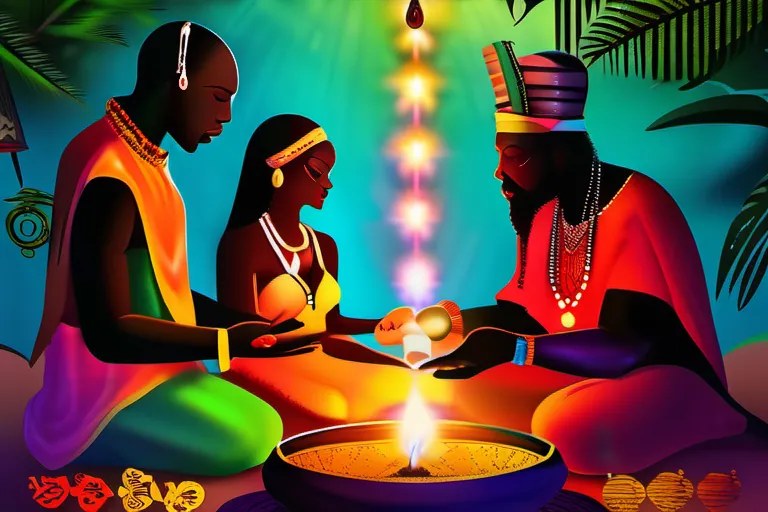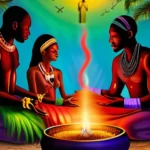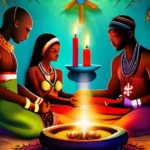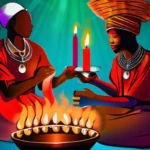Explore the fundamental beliefs, practices, and deities of Haitian Vodou, its history, and cultural significance.
Haitian religion, primarily Vodou, is a rich and complex system deeply rooted in African traditions. This article delves into the key teachings of this fascinating faith, providing valuable insights into its beliefs, practices, and deities.
The Origins of Haitian Religion
The origins of Haitian religion, Vodou, are deeply intertwined with the history of West Africa, particularly with the Fon, Yoruba, and Kongo traditions. Imagine a vast tapestry woven from these diverse threads; each strand represents a unique cultural tradition that came together to form something breathtakingly beautiful yet complex.
Let us delve into these roots. The Fon, an ethnic group from Benin in West Africa, brought with them the concept of ancestors and their continued influence on daily life. These spirits are often invoked for guidance and protection, much like seeking advice from a wise elder in times of need. Could it be that these ancestral connections form the backbone of Vodou’s spiritual practices?
The Yoruba, another significant contributor to Haitian religious traditions, introduced the pantheon of deities known as Orishas or Loa in Vodou. These powerful spirits govern various aspects of life, from weather and agriculture to personal destiny and health. Can we think of these deities as guardians, each with their own domain much like the守护神在各个领域都有各自的管辖范围?这使得Vodou的信徒们能够在面对生活中的各种挑战时,寻求相应的保护和指导。
And then there are the Kongo traditions, which brought the practice of divination and healing. These rituals often involve intricate dances and music, serving as a bridge between the physical and spiritual realms. Is it not fascinating how these practices create a space where the invisible world becomes tangible, allowing for profound personal revelations?
These African traditions were not just preserved but transformed in Haiti under conditions of slavery and oppression. The religion that emerged is a resilient blend, adapting to new circumstances while retaining its core spiritual essence. How can we understand Vodou without acknowledging its deep historical roots and the resilience it has shown over centuries?
The fusion of these diverse traditions in Haitian Vodou creates a rich, dynamic religious landscape that continues to evolve. It is more than just a collection of beliefs; it is a living tradition that reflects the enduring spirit of the Haitian people.
The Role of Deities in Haitian Vodou
The pantheon of Haitian Vodou deities forms the heart and soul of this vibrant spiritual practice, much like a complex ecosystem that supports life in nature. Who are these spirits, and what roles do they play in the lives of their followers? Are they just figures of worship or do they have deeper meanings?
Each deity, often referred to as Lwa, embodies certain attributes and is associated with specific domains such as love, agriculture, war, and protection. For instance, Damballa, the serpent deity, symbolizes wisdom and fertility; his presence in rituals ensures bountiful harvests and prosperity. Another notable figure is Erzulie Freda, who personifies beauty, love, and compassion, often invoked during celebrations of joy and unity.
The Lwas are believed to reside in the spiritual world but can interact with humans through possession ceremonies, a profound experience where worshippers temporarily embody these deities. These possessions are not just performances; they are deeply transformative, providing guidance, healing, and a sense of connection to the divine.
The significance of each Lwa within Vodou is multifaceted. They serve as intermediaries between humans and the spiritual realm, guiding believers through life’s challenges and offering protection. By honoring them, followers seek blessings, forgiveness, and a closer relationship with the spiritual world. It’s almost like having a diverse family of guardians who watch over you in different aspects of your life.
The deities of Haitian Vodou are more than just mythological figures; they are living entities that breathe through the rituals and practices that connect them to their followers. Each Lwa has its own unique story, like chapters in a vast and intricate narrative, waiting to be uncovered and understood.
In this world of spirits and deities, the role each plays is essential, much like the parts of an orchestra where every instrument contributes to the harmony. Together, they create a rich tapestry that defines Haitian Vodou and its deep cultural significance.
Practices and Rituals in Haitian Vodou
Imagine stepping into a vibrant and colorful ceremony where music, dance, and prayers blend seamlessly to honor Vodou. Practices and rituals in Haitian Vodou are not just about worship; they are deeply rooted in tradition and spirituality. How do these practices reflect the beliefs of the community?
One of the most striking aspects is possession, a spiritual state where deities or loa (spirits) temporarily take over individuals. Is it a dance, a trance, or something more profound? Participants often go into a deep state of concentration and movement, as if possessed by an unseen force. This phenomenon is not just observed; it’s experienced in the very heartbeat of the ceremony.
Offerings play a crucial role during these rituals. From libations to food offerings, each item serves a specific purpose. It’s like preparing a feast for honored guests—why do you think they are so important? These offerings are not just symbolic; they are an act of gratitude and respect, ensuring the continued presence of the loa in daily life.
Divination is another fascinating practice, often involving the use of objects or herbs to seek guidance from the spirits. Think about it—what mysteries lie behind these rituals? How do divinatory practices help individuals navigate their lives and make important decisions?
The intricate web of Vodou practices not only sustains spiritual connections but also strengthens community bonds. Every ritual is a communal effort, where participants come together to honor the loa and each other. In what ways does this collective practice enhance the sense of belonging in Haitian society?
The History of Haitian Vodou in Haiti
The history of Haitian Vodou in Haiti is like a complex tapestry, woven with threads from African traditions and French colonialism. How did this blend of beliefs emerge? Was it simply a result of forced cultural exchange, or was there something deeper at play? The origins of Vodou can be traced back to the late 17th century when enslaved Africans were brought to Haiti, where they found themselves stripped of their own religions and cultures. In this harsh environment, they had to find a way to hold on to their spiritual beliefs. How did these enslaved people manage to preserve their heritage amidst such oppression? They turned to Vodou, creating a syncretic religion that combined elements from various African traditions with Catholic saints, as if fusing different musical instruments into one symphony.
During the Haitian Revolution (1791-1804), Vodou played a pivotal role. It wasn’t just a spiritual practice but a weapon in the struggle for independence. How did Vodou become intertwined with the revolutionary movements? Was it seen as a force of subversion by the colonial powers, or was it embraced by the revolutionaries as a symbol of resistance and unity? The spirits (Lwa) were invoked not just to provide spiritual guidance but also to rally the people against their oppressors. Imagine a call to arms where each invocation of a Lwa brought more fervor and resolve among the fighters; Vodou was more than a religion—it was a battle cry for freedom.
After the successful Haitian Revolution, Vodou continued to shape the nation’s identity. It became a cornerstone of Haitian culture, influencing everything from music to literature. How did this newfound independence affect the practice and perception of Vodou? Did it become more openly practiced or was it still shrouded in secrecy due to lingering colonial fears? The history of Vodou is also marked by periods of persecution and acceptance. How has Vodou managed to endure such fluctuations, and what does this resilience tell us about its deep-rooted significance?
The role of Vodou in Haitian society extends far beyond the realm of religion. It encompasses a rich cultural heritage that has shaped the nation’s identity. As we explore further, one can’t help but wonder how much of Haiti’s vibrant culture and traditions are intertwined with this ancient practice. The history of Haitian Vodou is not just a chronicle of events; it’s a testament to the human spirit’s resilience and the enduring power of cultural resistance.
The Cultural Significance of Haitian Vodou
Have you ever wondered how a religion can shape a nation’s soul, influencing its art and music while playing a pivotal role in social structures? Haitian Vodou is not just a religious practice; it is a profound cultural tapestry woven deeply into the fabric of Haiti’s identity. How does one begin to understand this complex web of beliefs and practices?
Imagine a colorful tapestry, each thread representing a different deity or spirit in Vodou. These spirits, known as Lwa, are believed to be intermediaries between humans and the divine realm, offering guidance and protection to those who honor them. Each Lwa has its own unique personality, preferences, and even weaknesses—much like the characters in a richly detailed novel.
Vodou’s influence on art and music is undeniable. From vibrant paintings depicting Lwa ceremonies to lively rhythms played during festive gatherings, these expressions reflect the deep emotional and spiritual connections people have with their faith. Have you ever heard the drums echoing through the streets of Port-au-Prince? Those rhythmic beats are not just a sound; they are a call to connect with the Lwa and to celebrate life itself.
In terms of social structures, Vodou plays an integral role in providing community support and addressing societal issues. Temples, or gwo-kos, serve as centers where people can seek guidance, resolve conflicts, and find solace. The practice of Vodou offers a sense of belonging that goes beyond mere religious observance—it is a communal experience that binds Haitians together in times of joy and sorrow.
The cultural significance of Haitian Vodou cannot be overstated. It is more than just a set of rituals or beliefs; it is a living, breathing entity that continues to evolve while honoring its rich heritage. In exploring this religion, we uncover not only the spiritual dimensions but also the deep-seated social and emotional needs that have shaped Haiti’s unique character.
So, as you delve deeper into the world of Haitian Vodou, consider how it might resonate with your own experiences or cultural background. Perhaps there are threads in this complex tapestry that mirror your own beliefs and values?
Modern Expressions of Haitian Vodou
How does Haitian Vodou express itself today, both within Haiti and in the diaspora? It’s a question that requires us to peel back layers of history and identity to understand its modern manifestations. In contemporary Haiti, Vodou is not just a set of rituals but a vibrant cultural force that influences daily life. Imagine walking through the bustling streets of Port-au-Prince; can you picture the colorful flags and intricate symbols that speak volumes about the spiritual landscape? These symbols are more than mere decorations—they represent the loa, or spirits, who continue to play pivotal roles in Haitian society.
But Vodou’s influence extends far beyond Haiti’s borders. In the diaspora communities scattered across North America and Europe, Vodou practices have evolved yet remain deeply rooted. For many, participating in Vodou ceremonies is a way to maintain connections with their homeland and ancestors. These rituals often involve music, dance, and offerings that honor specific loa, creating a sense of community and belonging.
The modern expressions of Haitian Vodou are also seen in the arts. From literature to film, artists continue to explore themes of Vodou through their work, providing new interpretations for contemporary audiences. These artistic expressions often serve as platforms to challenge stereotypes and celebrate the richness of Vodou culture.
Moreover, Vodou plays a significant role in addressing socio-political issues. During times of crisis, such as natural disasters or political upheavals, Vodou communities come together to provide support and solace. It’s a testament to how deeply embedded Vodou is in the fabric of Haitian society, acting not just as a spiritual guide but also as a social safety net.
So, how do you navigate this complex web of beliefs and practices? It’s about understanding that Vodou is more than just a religion—it’s a way of life. For many Haitians and those in the diaspora, it’s a source of identity, resilience, and hope. As we delve deeper into its modern expressions, we must embrace the diversity and richness of these traditions, recognizing them as integral parts of global cultural heritage.
Conclusion
 By understanding the unique aspects of Haitian Vodou, we gain a deeper appreciation for the resilience and cultural richness of the Haitian people. This knowledge can foster greater empathy and cross-cultural understanding.
By understanding the unique aspects of Haitian Vodou, we gain a deeper appreciation for the resilience and cultural richness of the Haitian people. This knowledge can foster greater empathy and cross-cultural understanding.











